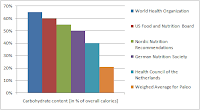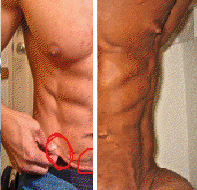 |
| Image 1: "Bikini Body Now!", headlines like this and the unfair suggestion that by following diet X or taking supplement Y you would make it onto the cover of a magazine like that are part of the problem why diets fail, people get discouraged and caught in the diet trap. |
The issue of
yoyo dieting and the existence and non-existence of a
body weight or
body fat set-point has been an issue in more than a handful of
SuppVersity posts, already (
click here to read more). None of the studies I cited (and not even one of those I have read) did yet provide a conclusive and
experimentally verifiable answer to the question whether or not there is such a thing as a "set point" and
how or even
if dieting influences the latter. What common "wisdom" would suggest, though, is that dieting will ruin your metabolism, so that both the post-dieting weight rebound, as well as future problems with losing weight would be programmed.
So the question is: Can you diet yourself fat? As I have pointed out in previous posts, as well, the hypothesis that you cannot only diet yourself fat, but also make it practically impossible ro reverse the damage is supported by a myriad of N=1 reports on the Internet, objective evidence, on the other hand, is very rare, often inconclusive and mostly either of epidemiological
or experimental nature.
In the case of the most recent study from the
Pennington Biomedical Research Center at the
Louisiana State University, this is yet somewhat different, as it is one of the few studies to combine a controlled dietary intervention with a focus on
lifestyle changes that went beyond just telling participants to cut calories (and fats ;-) and a detailed epidemiological analysis of the weight loss history of the subjects to produce a model that would actually allow predictions of future weight loss based on specific aspects of the weightloss history of a given individual.
 |
| Figure 1: Based on the diet history and the weight loss success during the 6-month weight loss intervention, the scientists developed a model to predict future weight loss - I would take the exact quantities with a grain of salt, but the qualitative trend, as well as the confounding factors are interesting (data based on Myers. 2012) |
As you can see in
figure 1, there is something like a "breaking point" at the
10+ diets margin, when it comes to the ability to lose weight. Aside from the fact that you will have all dieters with more than 10 diets packed in there (people could have dieted 100 times or more!), this is by no means evidence for the existence of negative physiological / metabolic side effects of dieting.
In view of another important finding of the study, which is the prognostic validity of
previous successful weight loss (
figure 1, left) as a positive indicator of future weight loss success, it is much more likely that people who failed 10 or more times, simply make the same mistake(s) over and over again - and while most of them are probably falling victim to one or another of the following culprits
Did you know that a reanalysis of data from the DiOGENES study, a large scale dietary intervention with participants all across Europe, yielded an astonishing result which is yet pretty much in line with the weight loss success of the biggest losers Myers et al. report?
According to Monica H.T. Wong and her colleagues, who scrutinized the weight loss and subsequent weight maintenance of 502 study subjects from 8 different study centers, those participants who lost the most weight during the initial 8-week weight loss phase on a very low calorie diet (800kcal/day) were also the ones who did best in staving the weight off!
Moreover, neither the starting weight nor the glucose sensitivity were significantly associated with the ability to weight and to avoid the dreaded weight rebound, in the course of the 6-months follow up (Wong. 2012). After the weight loss, on the other hand, those participants who lost the most weight also saw the greatest improvements in insulin resistance - ex-post, this could therefore at least be one physiological factor contributing to the long-term success of the biggest losers.
- following an unbalanced, single-sided / fad diet (e.g. cabbage diet, etc.)
- starving themselves for X weeks and falling off the wagon, before lasting results can even be achieve
- cheating too often / not cheating at all
- overexercising (and undereating)
- doing no exercise at all
- meticulously counting calories and grossing up energy expenditure (as measure with a heart rate monitor and pieces of cake eaten after the workout)
- eating too little protein to ever be satiated and keep your muscles from being cannibalized
- eating too much protein (and no carbs or fats) and running on cortisol and catecholamines until you crach
- (ab-)using fat burners (esp. stims) and burning out (cf. figure 1, right)
- seeking for the magic pill, both in supplement and diet form
- sticking to a diet, because it worked so well for X months, when your body has long changed and the previously optimal diet is now inappropriate for your novel you (e.g. following Atkins diet when you got rid of most of the blubber and turned to physical culture)
an older study by Xi et al. appears to suggest that one item that's not usually on lists like the above could pose a similar, if not even more pronounced thread even to the "educated" dieter.
Being in a very mild caloric deficit, is no solution, but a potential cause of the problem. In fact, "not dieting hard enough" could be just as detrimental, as any of the previously mentioned self-imposed obstacles.  |
| Figure 2: Total and resting energy expenditure of mice that were exposed to a -5% reduction in energy intake for 21 days (graph from Xi. 2010) |
This is at least what the results of a study from the
Department of Nutrition Sciences at the
University of Alabama at Birmingham, Birmingham in Alabama, would suggest.
In 2010, already, Xi et al. have shown that a
mild (=5%) reduction in energy intake is probably the worst approach to dieting rodents (and probably humans, as well ;-) can take, as it triggered...
- increases in fat mass (p < 0.01)
- decreases in lean mass (p < 0.01),
- decreases in total energy expenditure (p < 0.05) and
- resting energy expenditure (p < 0.05)
and all that within no more than 3 weeks and in the absence of reduction in locomotor activity (Xi. 2010) - which means that you cannot exercise these detrimental effects away!
The HIID solution: High Intensity Interval Dieting to get ripped and stay ripped? You may now certainly complain that
biggest losers and mice are nothing you want to go by and you are certainly right; yet still, the notion that
slow and steady is not the way to go is also corroborated by results of another 2010 study, this time done in humans and not from Alabama, but from the
Washington University School of Medicine, where Fontan et al. conducted an ex-post analysis of the effects of
really long-term moderate caloric restriction (and endurance exercise) on insulin-sensitivity and glucose management.
The subjects of the study were 28 volunteers, who had been eating a calorically restricted diet for an average of 6.9 +/- 5.5 years, (mean age 53.0 +/- 11 years), 28 age-, sex-, and body fat-matched endurance runners (EX), and 28 age- and sex-matched sedentary controls eating the SAD or standard Western diet (WD). (Fontana. 2010):
 |
| Figure 3: Parameters of glucose management in 23 subjects who have been following a calorically restricted diet for ~7y (range 3–20 years; CR) and 28 endurance runners who had been training for an an average of 21 years (range 5–35y; 20 to 90miles/week) relative to 28 sedentary (regular exercise <1 h per week) age and sex matched individuals eating typical Western diets (WD); data calculated based on Fontana. 2010. |
Probably much to the surprise to all researchers who love their worms and fruit flies and still believe that starving was the solution to all your problems, Fontana et al. found that long-term caloric restriction
in the absence of exercise had statistically highly significant negative consequences on glucose tolerance, as measure in a standardized oral glucose tolerance test (
figure 2, small graphs). What's particularly interesting though is that
- the non-exercising long-term calorie restricters were practically insulin resistant and still had perfect HOMA-IR values, and that
- among long-term dieters there were only 11 subjects (CR-IGT subgroup) who were so glucose intolerant that the result was still statistically significant, though the other 12 subjects' (CR-NGT subgroup) ability to clear the glucose from the bloodstream was in the normal range
Now, while former (1) does tell you much about the validity of HOMA-IR values as a marker of insulin resistance in people on long-term calorie restriction, the latter (2) observation flies right into the face of the "cut your calories to live longer and healthier" paradigm - after all, those 11 calorically restricted subjects had apparently become (or maintained?) glucose intolerant despite having lower BMIs and lower caloric intakes than their peers (1,858 kcal/day, BMI 18.6 vs. 1,729kcal/day, BMI 20 in glucose tolerant caloric restriction subjects, CR-NGT).
Due to the size of the two subgroups in the calorie-restricted group on which Fontana et al. conducted a sub-analysis, we cannot come to any clear-cut conclusions with respect to physical mechanisms that would explain the general tendency towards a reduced glucose tolerance and the intra-group differences between those who stayed glucose tolerant and those who are now underweight, malnourished and still glucose intolerant:
Dont fall for the false believe that being "normal weight" or even skinny means being healthy! Researchers from the Mayo Clinic in Rochester have found only recently that subjects with normal BMI but central obesity as defined by a high waist-to-hip ratio had
the highest cardiovascular death risk and the
highest death risk from all causes among the six subgroups (normal weight / overweight / obese x normal waist-to-hip ratio / high waist-to-hip ratio). The risk of cardiovascular death was 2.75 times higher and the risk of death from all causes was 2.08 times higher in normal weight obese people as compared with subjects with normal BMI and normal waist-to-hip ratio. And Dr Lopez-Jimenez points out: "Our research shows that if a person has a normal BMI, this by itself should not reassure them that their risk for heart disease is low. Where their fat is distributed on their body can mean a lot, and that can be determined easily by getting a waist-to-hip measurement, even if their body weight is within normal limits." In lights of the increased fat deposition in the aforementioned rodent study by Xi et al., constant calorie restriction is thus probably not the way to lead a healthy, let alone happy life (ESC. 2012).
"To try to obtain some insight regarding the mechanism responsible for this difference, we did a post hoc evaluation of the data. There were no significant differences between the CR-NGT and CR-IGT groups in either the HOMA-IR (0.32±0.20 versus 0.24±0.10) or the ISI (19.6±7.6 versus 16.8±4.7). Fasting plasma glucose, insulin, and C-peptide concentrations were similarly low in the two CR subgroups. Plasma 30-, 60-, 90-, and 120-min glucose concentrations were significantly higher in the CR-IGT subgroup than in the CR-NGT subgroup. Glucose AUC was significantly higher in the CR-IGT group than in the CR-NGT subgroup. Plasma insulin and C-peptide concentrations after the glucose load were not significantly different between the two CR subgroups except for the 120-min C-peptide value, which was higher in the CR-IGT groups. Insulin AUC and C-peptide AUC were not significantly different between the CR-IGT group and the NGT-CR group." (Fontana. 2010)
If you take closer look at the actual data there are however certain parameters that
could at least point into the right directions for future research and provide us with some clues that may help us in setting up our own dietary regimen.
Though not statistically significant (mostly a result of the small size of the dataset for this sub-analysis with N=11 and N=12 subjects in each group), there are a couple of things, it cannot be negated that the
insulin tolerant subjects had ...
- 33% higher IGF-1 + 78% higher testosterone levels,
- 36% lower fiber intakes + 28% greater VO2MAX
- 8% higher BMIs
than their insulin resistant peers. Now, you tell me what does "Lower fiber intake, higher IGF-1, higher testosterone, higher BMI" sound like?
Yeah, exactly the
nightmare of every physician and exactly what the medical orthodoxy would consider to be indicators of a skewed metabolism and would be trying to solve by putting you on a fiber-laden energy, fat, nutrient and often even protein deficient diet that may work as long as you are morbidly obese and every pound less on the scale takes you one step away from dying from a heart attack but will make you, an already (more or less) lean physically active individual
starve yourself into an asexual catabolic state, of which I do not believe and do not even care if it will allow me to live 2 or maybe even 10 years longer...
 |
So what? Conventional wisdom will tell you that the first diet is always the most successful one, that you will regain weight after dieting, no matter what, and that it will become increasingly difficult to get rid of the fat and avoid the yoyo effect.
And in fact, all this will become true, as long as you do your very best to make it become a self-fulfilling prophecy by setting yourself unattainable goals (e.g. "by tomorrow everything will be different") and regarding your "diet" as a temporary step to get from A to B (e.g. "I lost 50 pounds! Hurray, let's party for the rest of the year...") |
Implications: Before I get into an essentially pointless rant, let's briefly recapitulate what
main, or I should say
most relevant outcomes of the individual studies were:
- Myers' and Wong's studies "proof" only one thing: You got to be prepared to and actually make lifestyle changes! If you do, you will have success, huge success, in fact, in losing and staving off the weight.
- Xi's and Fontana's studies, as well as the recent results from the Mayo Clinic, on the other hand, underline the fallacy of lifelong dieting. If anything, it is this, i.e. never eating to satiety, always counting calories and disregarding the mandatory nature of exercise, that's underlying reason of "diet resistance" and "diet induced obesity"
None of the studies, however provides significant evidence, let alone "proves", that there was a
general physiological response to intentional weight loss that would make subsequent reductions in body weight harder and maintaining your weight (assuming this is not already in the skinny / anorexic zone) near to impossible!
The general message should thus be clear: A "diet" (as in restricted eating) is always just a temporary tool to be used within the broader context of lifestyle changes that are designed to maintain a healthy weight and improve the cardiovascular, and metabolic fitness that is the cornerstone of every goal in the SuppVersity's navigation bar, i.e. staying healthy & improving longevity, boosting performance, building muscle, losing fat and even having a fulfilled sex life... and don't fool yourself and take any of those for granted!
- Anderson JW, Konz EC, Frederich RC, Wood CL. Long-term weight-loss maintenance: a meta-analysis of US studies. The American Journal of Clinical Nutrition. 2001; 74: 579–584.
- European Society of Cardiology (ESC). Normal weight individuals with belly fat at highest CVD risk. ScienceDaily. August 27, 2012. < http://www.sciencedaily.com /releases/2012/08/120827074153.htm > retrieved August 29, 2012.
- Fontana L, Klein S, Holloszy JO. Effects of long-term calorie restriction and endurance exercise on glucose tolerance, insulin action, and adipokine production. Age (Dordr). 2010 Mar;32(1):97-108.
- Li X, Cope MB, Johnson MS, Smith DL Jr, Nagy TR. Mild calorie restriction induces fat accumulation in female C57BL/6J mice. Obesity (Silver Spring). 2010 Mar;18(3):456-62.
- Myers VH, McVay MA, Champagne CM, Hollis JF, Coughlin JW, Funk KL, Gullion CM, Jerome GJ, Loria CM, Samuel-Hodge CD, Stevens VJ, Svetkey LP, Brantley PJ. Weight loss history as a predictor of weight loss: results from Phase I of the weight loss maintenance trial. J Behav Med. 2012 Aug 21.
- Wong MHT, Holst C, Astrup A, Handjieva-Darlenska T, Jebb SA.Caloric Restriction Induces Changes in Insulin and Body Weight Measurements That Are Inversely Associated with Subsequent Weight Regain.PLoS ONE. 2012; 7(8):e42858.













































